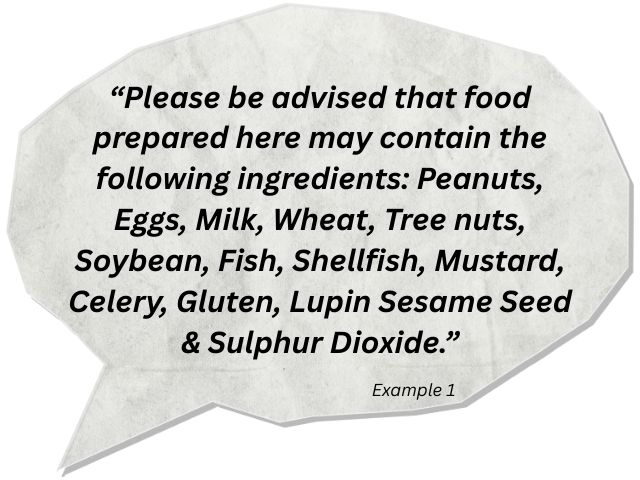Preventing Cross-Contamination
Cross-contamination risks when eating out and how to avoid gluten exposure


Fast Facts:
⚡ Cross-contamination happens when gluten free food contacts gluten (via surfaces, utensils, hands, or shared cooking spaces). Even tiny amounts can harm coeliacs
⚡ Common sources of cross-contamination include shared fryers, prep areas, equipment, and storage
⚡ Restaurants follow strict food safety rules to minimise risk of cross-contamination, but no mixed kitchen can be classed as 100% gluten-free
⚡ Always communicate your dietary needs and ask key questions such as "Are chips fried in a dedicated gluten free fryer?"
⚡ Menu disclaimers vary, some are more reassuring than other generic disclaimers
⚡ Even accredited venues provide disclaimers because total gluten elimination isn’t possible
⚡ Coeliacs must be extra cautious - understand risks, ask the right questions, and choose restaurants carefully for a safer gluten free dining experience
⚠️ Understanding Cross-Contamination Risks
For people with coeliac disease or gluten sensitivity, eating out can be challenging due to the risk of cross-contamination. Cross-contamination occurs when gluten free food comes into contact with gluten containing ingredients, surfaces or utensils. Even tiny amounts of gluten can trigger severe autoimmune reactions in people with coeliac disease. Whilst people with gluten intolerance may tolerate small traces, coeliacs must be vigilant about avoiding cross-contamination, regardless of whether they experience symptoms.
🧈 Common Sources of Gluten Cross-Contamination
Cross-contamination can occur in several ways, primarily through people-to-food, food-to-food and equipment-to-food contact. Below are some of the most common sources of gluten exposure in restaurant kitchens:
- Shared fryers - One of the most risks occurs when gluten free items, like chips or gluten free battered products, are fried in the same oil as gluten containing foods, making them unsafe
- Shared preparation areas - Counters, chopping boards and workspaces used for both gluten containing and gluten free food pose a significant risk
- Utensils & equipment - Shared knives, tongs, toasters, pizza cutters, and other kitchen tools can transfer gluten
- Hands & gloves - If staff handle gluten containing items and then touch gluten free food without changing gloves or washing hands, cross contamination occurs
- Storage - Using the same containers, trays, or display cabinets for both gluten free and gluten containing food increased the risk
- Condiments - Butters, spreads, and condiments can be contaminated if previously used with a gluten contaminated utensil
📉 Minimising the Risk
Whilst no shared kitchen can be 100% free from possible gluten contamination unless it’s entirely gluten free, that doesn’t mean that eating out is impossible.
Strict food safety regulations require restaurants to implement proper food handling procedures, including training, hygiene protocols, ingredient labelling, storage separation, and allergen management. When these procedures are followed, restaurant kitchens can be as safe as a shared home kitchen - though some level of risk always remains.
👉🏽 For more details, read about Food Safety Legislation and Training
💬 How to Communicate Your Dietary Requirements
Even when an item is labelled ‘GF’, it may not be safe for someone with coeliac disease due to how it is prepared and cooked. For example, gluten free foods may share a fryer with gluten containing foods.
To ensure your safety, always inform your server of your dietary requirements and ask key questions such as:
"Are the chips fried in a dedicated gluten free fryer?"
"How are gluten free pizza bases cooked?"
"Do you use a dedicated gluten free toaster or a shared one?"
"Can you add a note to my order stating that I have coeliac disease?"
Some menus will highlight potential cross-contamination risks with disclaimers, especially for items that share a fryer. However, this isn’t always the case and can be misleading especially when these shared fryer items are listed on a dedicated gluten free menu, so it's best to double check with your server or an allergen matrix.
👉🏾 For more guidance, read about communicating your dietary requirements here
📃 Cross-Contamination Declarations
Most restaurants that are not entirely gluten free include disclaimers on their menus stating that while they offer gluten free options, cross-contamination may still occur. Even gluten free accredited venues typically have a similar disclaimer, as complete elimination of cross-contact in mixed kitchens is nearly impossible. The wording of these disclaimers varies and can affect your confidence in their food safety practices.
1️⃣ Example 1

2️⃣ Example 2

Both of these statements are ways of explaining cross-contamination risks but example 2 provides a clearer explanation and reassurance that the restaurant takes precautions to minimise risks. Example 1 sounds like they've not put any thought into the statement, nor its meaning, and just listed all 14 major allergens - even though it's unlikely they'd all be present in the kitchen...
You may also encounter restaurants that include a statement such as:
"Please be aware we are unable to serve guests with any kind allergies (mild, severe or cross) or any kind of intolerance."
Whilst this statement may seem dismissive, some establishments lack the resources to control cross-contamination risks in small kitchens. However, by excluding all dietary requirements, they also exclude a significant portion of potential customers. The statement could also be questioned by environmental health specialists and whether they have any food safety controls in place.
🍴 Be Cautious of Buffets
Buffets pose a significant risk for gluten cross-contamination due to shared serving utensils, food proximity, and handling practices. Here’s what you need to know:
- Shared utensils - Spoons, tongs, or ladles can transfer gluten from one dish to another
- Food placement - Items like croutons, breadcrumbs, or flour-based sauces can fall into naturally gluten free dishes
- Double dipping - Guests may use the same utensil across multiple dishes, spreading gluten
- Gloved handling - Staff may touch gluten-containing foods and then serve gluten free options without changing gloves
- Condiment and toppings bars - Open bowls of dips, spreads, or salad toppings can easily be contaminated
🛟 How to minimise risks:
- Ask staff about gluten free options - Ensure they understand cross-contamination risks
- Request fresh portions - If possible, ask for untouched servings from the kitchen
- Avoid self-serve items - Choose pre-packaged or separately plated gluten free options when available
- Skip the buffet - If unsure, consider eating beforehand or bringing safe snacks
🎯 Quick Recap
Every restaurant that is not 100% gluten free carries some level of cross-contamination risk. Even gluten free accredited venues include disclaimers, such as complete isolation of gluten in shared environments is impractical. However, strict food safety regulations are in place to help minimise this risk, ensuring that restaurants follow paper procedures to accommodate dietary requirements, including allergies and coeliac disease.
Whilst those with gluten intolerance may be able to tolerate trace amounts, coeliacs must be extra cautious and actively avoid potential cross-contact. By understanding these risks, asking the right questions (specifically about shared fryers), and selecting restaurants carefully, you can enjoy eating out safely gluten free.